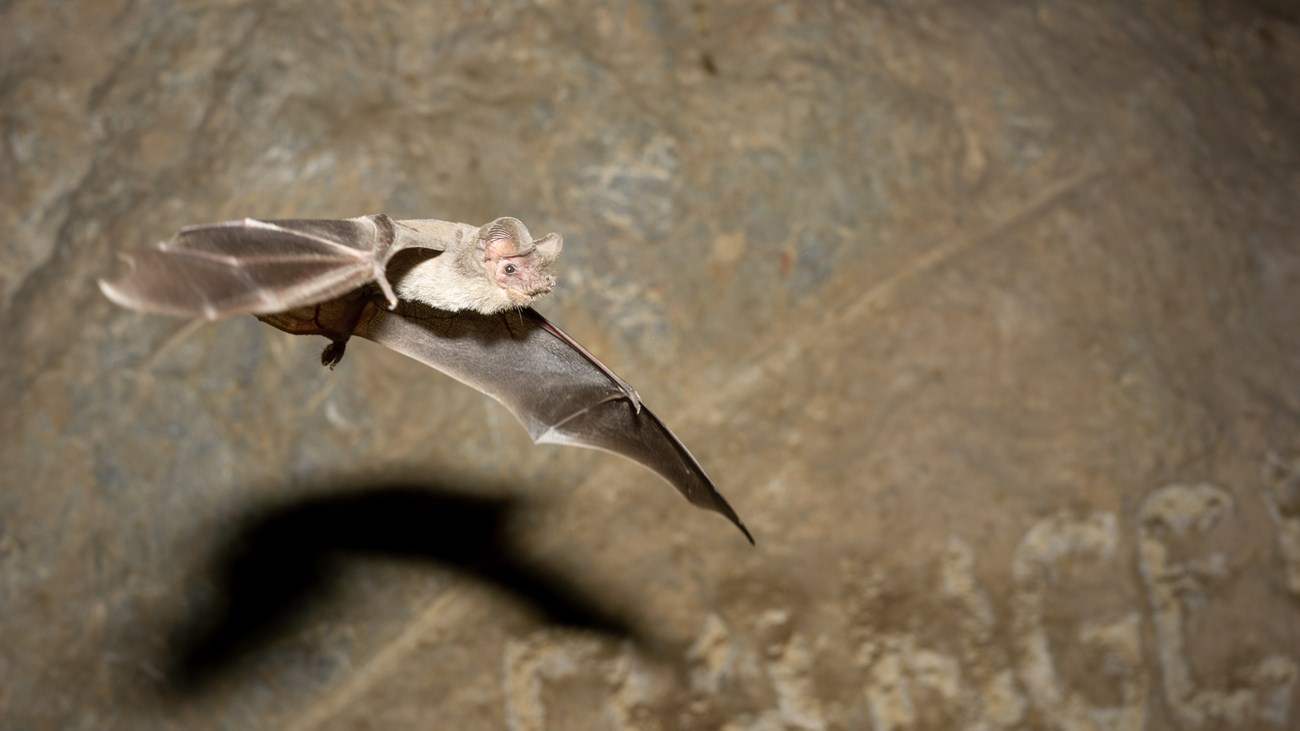
Photo by Joseph Danielson, Nevada Department of Wildlife About one-fourth of all mammals (nearly 1,000 species) on Earth are bats. Bats account for about 20 percent of the mammals in these parks, and many of the bat species (at least 17 of 25) in California use Sierra Nevada habitats. Bats are often misunderstood and underappreciated. But they play important roles where they live. 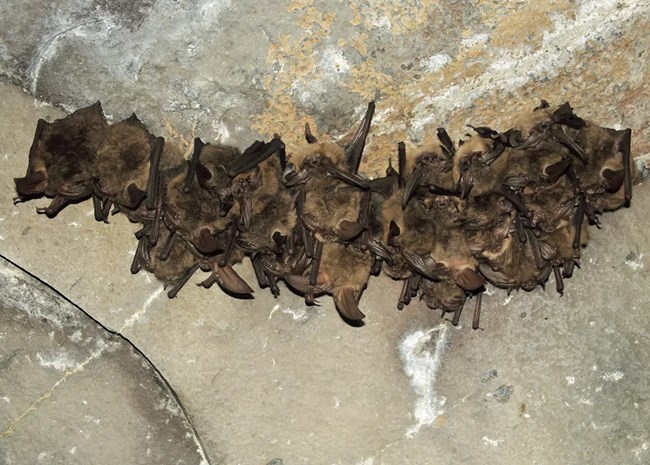
NPS / Shawn Thomas Benefits of BatsBats benefit caves and other places they roost by providing important nutrients in their guano that can be used by other organisms. These parks have at least 275 caves, some of which provide roosting habitat for bats. Bats also roost on cliffs, in trees, under leaves on the ground, under bridges, and on buildings. Where they prefer roosting varies by species. 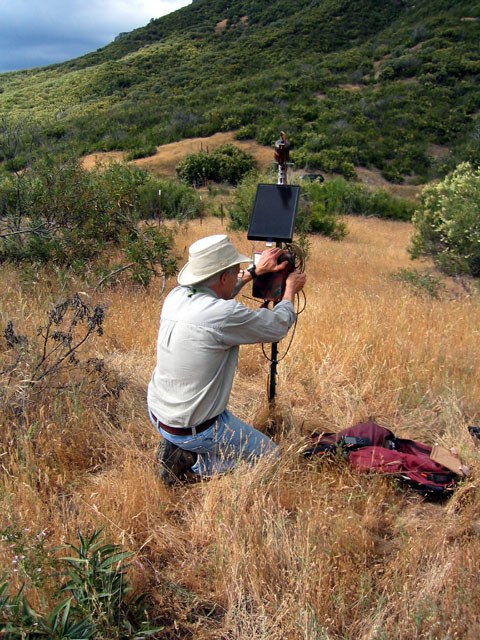
Photo courtesy of Elizabeth Pierson How do scientists study bats?Scientists who study bats need to be willing to work at night, when bats are most active. They use a couple different methods to detect or capture bats:
Acoustic MonitoringScientists record the ultrasonic echolocation calls of bats flying overhead. Bats find food by emitting these high-frequency calls and using their sensitive hearing to detect echoes from flying insects and locate them. Some of the species have unique call characteristics (such as the call frequency, shape, duration, and pulse intervals) that can be used to identify species from the recorded data. 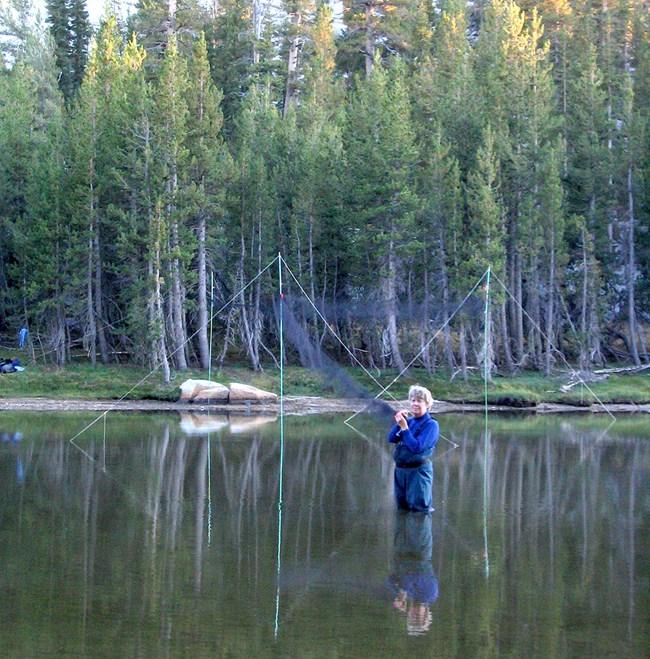
Photo courtesy of William Rainey Capture TechniquesThere are a few ways scientists capture bats at entrances/exits to roost sites in caves as well as in areas where they forage for flying insects, moths, and other prey — such as streams, meadows, ponds, and ripiarian areas. In the bat inventory for these parks, scientists used mist nets set up in meadows, ponds, or streams to capture bats. They identify the species, weigh them, determine whether male or female, check their condition, and collect additional measurements before releasing the bats. What bats live in these parks?Seventeen species of bats occur year-round or seasonally in these parks (see table below). Scientists Elizabeth Pierson and Bill Rainey conducted field surveys from 2001-2006, and also searched museum records and the scientific literature to document these species and their habitats. A combination of two field survey techniques were used to document these bats (described above): capturing bats in mist-nets stretched out in areas where bats forage for food, and acoustic detection that can identify distinctive calls of some species. This project was funded and managed through the Sierra Nevada Inventory & Monitoring Network.
Profiles of Three Bat Species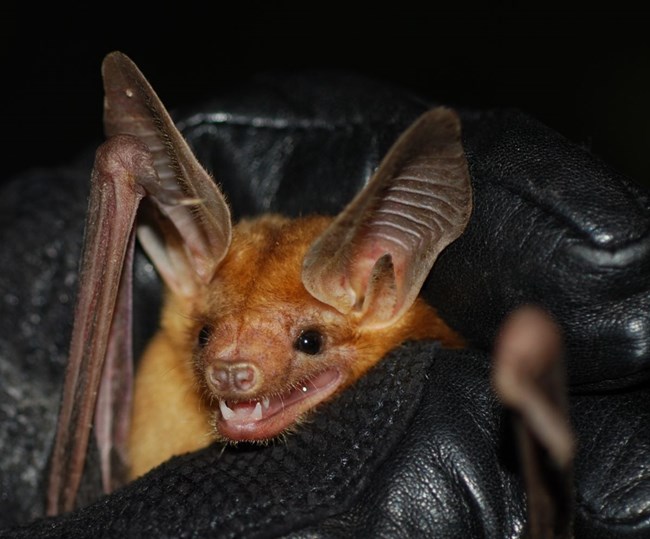
Photo by Keith Paul, US Fish and Wildlife Service Pallid BatWhat do they look like?This bat is pale (blonde to tan) with large ears, a blunt pig-like snout, and a skunk-like odor that may discourage predators. It is relatively large, 3.5- 5 inches (9.2-13.5 cm) from head to tail, and has a wingspan of about 13 inches (35 cm). The prominent ears have special traits that help these bats hear well and perceive sound through echolocation (emitting sound waves to navigate). Their large eyes and sharp vision help them locate prey at night. Foraging Habits and Favorite FoodsThese bats forage low over the ground in relatively open areas. They feed primarily on large, ground-dwelling prey – scorpions, Jerusalem crickets, cicadas, wolf spiders, centipedes, and some types of beetles. During nocturnal foraging, a pallid bat can consume up to 100 percent of its body weight in food! Where do they live?The pallid bat ranges from western Canada through the west and central U.S. and down into Mexico and Cuba. In these parks, pallid bats are most associated with low elevation blue oak woodland and mid-elevation black oaks, ponderosa pine dominated forests, and giant sequoia groves. To roost, they use tree hollows, rock crevices, caves, abandoned mines, and human structures such as buildings and bridges. Migration/HibernationThese bats do not appear to migrate any great distance as the seasons change. They break into smaller groups and hibernate deep within crevices of canyon walls, in buildings, or deep in caves. Not much is known about where they may hibernate in these parks. 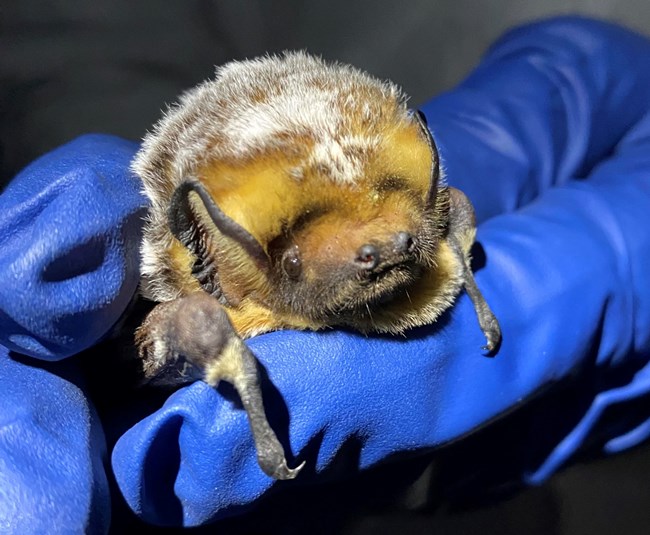
Photo by Sarah Barsch, Conservation Legacy and NPS Mojave Desert Network. Hoary BatWhat do they look like?The hoary bat is named for its distinct grey-white appearance. Their fur is very glossy, and a mixture of yellowish-brown, dark brown, and white – giving them their frosty appearance. They are 5-6 inches (12.7- 15.2 cm) long, and have a wingspan of about 15 inches (38.1 cm). They have a furry tail membrane that they wrap themselves in for warmth when they roost in trees. Foraging and Favorite FoodsHoary bats are relatively fast fliers with limited ability to maneuver through forests, so favor open areas such as rivers and streams, bodies of water, meadows, open forests, or over the tops of trees for foraging. They mainly feed on large moths but also eat other invertebrates such as butterflies, beetles, dragonflies, mosquitos, and termites. Where do they live?They are the most widespread bat in the Americas, with a range stretching from southeast Canada to Hawaii. Their range extends south to Guatemala, and from Brazil to Argentina and Chile in South America. In these parks, hoary bats are widespread, detected from the lowest to the highest elevations. While roosting sites in the park were not identified in this study, these bats are solitary rather than colony roosting species. They are frequently associated with riparian areas and presumed to roost in trees such as sycamore, cottonwood, and mature willow. When they roost, they typically hang from one foot and look like a dry leaf in a tree. Migration/HibernationInstead of spending winter months hibernating in colonies, the hoary bats migrate to warmer winter habitats. After mating in autumn, females will move to the northern, eastern, and central United States to give birth, often to twin pups, in mid-May to early July. Males will remain in the mountainous areas of the western United States in the spring and summer, so it is primarily males of this species that has been documented in these parks. Some individuals may over-winter at the lower, warmer elevations of these parks. 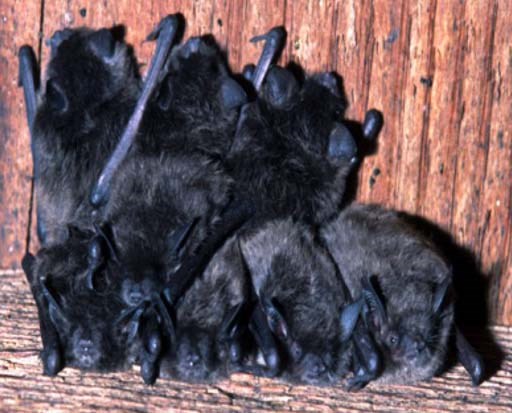
Photo courtesy of William Rainey Yuma MyotisWhat do they look like?This is a relatively small bat, measuring 1.5 to 1.9 inches (3.9-4.8 cm) in head-body length, with an average wingspan of 9.4 inches (24 cm). They only weight about 0.21 oz (6 g). They vary in color across their range, and can be anything from dark brown to pale tan or even greyish with light colored fur on their underside. Foraging and Favorite FoodsThese bats typically forage over water in forested areas. They prefer forested edges of streams. They eat a wide variety of invertebrates, including moths, froghoppers, leafhoppers, June beetles, ground beetles, spiders, midges, mosquitoes, and various types of flies. Where do they live?The Yuma myotis is found throughout western North America, from British Columbia through Washington, Idaho, and western Montana, southern Wyoming, Colorado, New Mexico, West Texas and into Mexico. Yuma myotis reside in moist and dry forests, riparian zones, grasslands, shrubsteppe, and deserts, and are closely associated with rivers, streams, ponds, and lakes. Although their natural roosts include caves, rock crevices and hollow trees, they are more commonly found today in structures like bridges and buildings close to water. Tree cavities are important as nursery roost sites – where the mothers will shelter their young. Migration/HibernationThese bats are relatively inactive during winter, spending some of their time in torpor, but probably do not migrate any distance. While in torpor, they have decreased activity, marked by a reduced body temperature and metabolic rate. What are major threats to bats?Climate ChangeIn North America, extreme temperatures and drought are the biggest threats to bats from climate change. Heat waves and severe storms have already killed many bats, and these extreme events continue to threaten bats and other wildlife. DiseaseThe disease White-nose Syndrome (WNS) is caused by a non-native fungus, and since its detection in New York state in 2006, WNS has killed millions of bats. Infecting skin and membranes of bats during hibernation, the fungus causes bats to be aroused too frequently, using up their fat stores and starving before the end of winter. Although not detected in the Sierra Nevada yet, it has been detected in northern California, Washington state, and New Mexico. Habitat LossLoss of habitat means bats have less of the natural spaces and resources available that they need to survive and thrive. A few examples of habitat loss are:
Wind Energy ProductionRoughly half a million North American bats die each year from colliding with wind turbines. While wind energy production helps meet electricity demands with renewable energy sources, it can be made safer for bats. ConservationWhile bats face many threats and some are in danger of extinction, there is an increasing number of scientists and others working to protect these important animals. Learn MoreBats in National Parks |
Last updated: September 28, 2023
